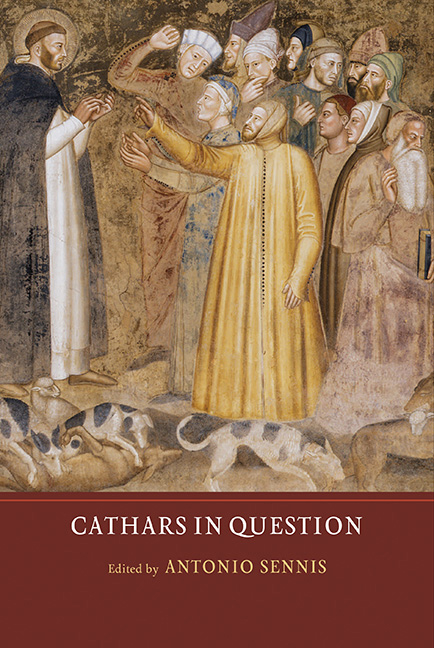Book contents
- Frontmatter
- Contents
- Acknowledgments
- 1 Questions about the Cathars
- 2 The Paradigm of Catharism; or, the Historians’ Illusion
- 3 The Cathar Middle Ages as a Methodological and Historiographical Problem
- 4 The Heretical Dissidence of the ‘Good Men’ in the Albigeois (1276–1329): Localism and Resistance to Roman Clericalism
- 5 The Heretici of Languedoc: Local Holy Men and Women or Organized Religious Group? New Evidence from Inquisitorial, Notarial and Historiographical Sources
- 6 Cathar Links with the Balkans and Byzantium
- 7 Pseudepigraphic and Parabiblical Narratives in Medieval Eastern Christian Dualism, and their Implications for the Study of Catharism
- 8 The Cathars from Non-Catholic Sources
- 9 Converted-Turned-Inquisitors and the Image of the Adversary: Ranier Sacconi Explains Cathars
- 10 The Textbook Heretic: Moneta of Cremona's Cathars
- 11 ‘Lupi rapaces in ovium vestimentis’: Heretics and Heresy in Papal Correspondence
- 12 Looking for the ‘Good Men’ in the Languedoc: An Alternative to ‘Cathars’?
- 13 Principles at Stake: The Debate of April 2013 in Retrospect
- 14 Goodbye to Catharism?
- Index
- Miscellaneous Endmatter
9 - Converted-Turned-Inquisitors and the Image of the Adversary: Ranier Sacconi Explains Cathars
Published online by Cambridge University Press: 31 March 2017
- Frontmatter
- Contents
- Acknowledgments
- 1 Questions about the Cathars
- 2 The Paradigm of Catharism; or, the Historians’ Illusion
- 3 The Cathar Middle Ages as a Methodological and Historiographical Problem
- 4 The Heretical Dissidence of the ‘Good Men’ in the Albigeois (1276–1329): Localism and Resistance to Roman Clericalism
- 5 The Heretici of Languedoc: Local Holy Men and Women or Organized Religious Group? New Evidence from Inquisitorial, Notarial and Historiographical Sources
- 6 Cathar Links with the Balkans and Byzantium
- 7 Pseudepigraphic and Parabiblical Narratives in Medieval Eastern Christian Dualism, and their Implications for the Study of Catharism
- 8 The Cathars from Non-Catholic Sources
- 9 Converted-Turned-Inquisitors and the Image of the Adversary: Ranier Sacconi Explains Cathars
- 10 The Textbook Heretic: Moneta of Cremona's Cathars
- 11 ‘Lupi rapaces in ovium vestimentis’: Heretics and Heresy in Papal Correspondence
- 12 Looking for the ‘Good Men’ in the Languedoc: An Alternative to ‘Cathars’?
- 13 Principles at Stake: The Debate of April 2013 in Retrospect
- 14 Goodbye to Catharism?
- Index
- Miscellaneous Endmatter
Summary
Ego autem frater Rainerius, olim heresiarcha, nunc gratia Dei sacerdos in ordine Predicatorum licet indignus, dico indubitater et testificor coram Deo, qui scit quod non mentior, quod aliquod illorum trium non est inter Catharos sive in penitentia eorum.
It is 1250, and Brother Ranier, a middle-aged Preacher and former dualist heretic from Piacenza (Lombardy), writes a treatise about his former fellow believers, the Cathars. Following Ranier himself, who shaped his identity as an ex-heresiarch and later Brother Preacher, my approach to this subject takes into account Ranier and his work together, and considers that in anybody's life experience both past and present contribute to building up a whole individual, and that this individual's writings are necessarily – at least to some extent – the expression of this entirety. In other words, this ex-heretic turned-inquisitor wrote about his former companions not only as a convert who hid the acrimony and resentment typical of an apostate, but also as an inquisitor, bringing his own life, experience and problematic past into his textual construction of the heretical ‘adversary’.
Ranier's work, of little literary but enormous historical value, enjoyed great success – nineteen manuscripts containing all, or excerpts of, the Summa have been counted in the most recent survey by Käppeli, scattered throughout Europe. This is a telling figure, especially if compared to the two works most closely related to the Summa: the treatise attributed to Peter of Verona (1230–8) – known through two manuscripts – and Anselm of Alessandria's Tractatus (1267–70), of which only one version is extant. (The nature of the connection between these works will be discussed below.) Ranier's popularity is confirmed also by his frequent contacts with the papacy after his conversion: three different pontiffs (Innocent IV, Urban IV and Alexander IV) wrote to him frequently in the decade 1252–62, addressing their letters to him personally (‘to my beloved son in God Ranier, inquisitor in Lombardy’).
What surprised me most, however, is that Ranier does not feature equally prominently in his order's records and celebratory works.
- Type
- Chapter
- Information
- Cathars in Question , pp. 185 - 207Publisher: Boydell & BrewerPrint publication year: 2016



